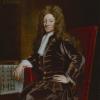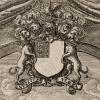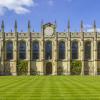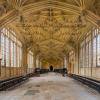Introduction: architecture becomes a liberal art
Commentary
Portrait of Sir Christopher Wren
By Sir Godfrey Kneller, Bt., oil on canvas, 1711; 49 in. x 39 1/2 in. (1245 mm x 1003 mm). Source: National Portrait Gallery 113 (CC by-nc-nd/3.0). Further detail on the portrait available here.
Of all the visual arts – painting, sculpture, and architecture – architecture arguably required the most physical labour and was certainly the most utilitarian: shelter, after all, is one of the most basic requirements of human life. The laborious pursuit of utilitarian goals is of course the hallmark of the ‘vulgar’ or ‘mechanical’ arts which were excluded from the medieval and early modern university curriculum and from the activities deemed suitable for a gentlemen. At the beginning of the seventeenth century, architecture was therefore still the preserve of the master mason, a semi-learned artisan who had typically worked his way up through the building trade. Classical architecture, meanwhile, was completely absent from the Oxford cityscape before 1599.
By the end of the seventeenth century, however, architecture’s status had been transformed. The scale of this transformation can be glimpsed in this portrait from 1711 of the first great English baroque architect, Sir Christopher Wren (1632-1723). The grand posture, the haughty expression -- observing the viewer out of the corner of his eye, as it we are not worth the effort required to turn the head -- the extravagant wig, the lace neckpiece, the white cuffs, the rich jacket of purple velvet, and the pale complexion: all these beyond doubt are the attributes of a very fine gentlemen.
How had this transformation come about? Again, this portrait contains some important clues. The dividers grasped in the right hand are the most basic mathematical instrument of the geometer. The great delicacy of the grip within the fine fingers of a spotless white hand suggests manual work of only the most subtle kind, more gentle even than the act of writing itself. On the velvet-covered table rests a leather-bound copy of Euclid’s Elements, also reminding the viewer of the grounding of architecture in both classical learning (Euclid was the ancient Greek authority on geometry) and the liberal art of mathematics (firmly situated within the quadrivium). Beneath it is Wren's supreme accomplishment, St Paul's Cathedral, depicted as an architectural plan, a relatively new form of abstract representation which must have seemed almost as inscrutable to many of Wren's less numerate contemporaries as the most complex geometrical figure from pure mathematics.
These three elements – the distance from manual labour, the admixture of classical erudition, and the grounding in mathematics – were crucial to establishing architecture as a learned, liberal discipline. Reciprocally, the importance of geometry to classical architecture helped to elevate mathematics as a subject necessary for and therefore suitable to the education of a gentlemen. And this rise in the status of mathematics, in turn, was a precondition of the quantification of the natural sciences.
Wren epitomises every aspect of this process. As Gresham Professor of Astronomy (1657-61) and Savilian Professor of Astronomy (1661-73), he devoted the early years of his career to promoting the study of a mathematic discipline in both London and Oxford. It was immediately after one of his Gresham lectures that the inaugural meeting of the Royal Society of London was held, of which Wren was a founding member and later briefly a president (1680–1682). As architect of the University’s first, free-standing classical building, the Sheldonian Theatre (1664-69), he played a major role in the introduction of classical architecture into Oxford.
In short, although traditionally regarded as an ‘art’ rather than a ‘science’, architecture played a not insignificant role in raising the status of mathematics within the university curriculum, in elevating one of the mechanical arts as an activity worthy of a gentleman, and in contributing to the culture in which a new, mathematical approach to natural philosophy could take root. This unit is devoted to studying some of these interconnections.
This process began well before Wren was born. In Oxford, the first stirrings of the classical architectural tradition can be seen in the first years of the seventeenth century, as the university’s halls and colleges began to rebuild themselves, however tentatively, in a classical manner. The best vantage point for observing the ascent of classical architecture and the mathematics associated with it is to trace the process in which the five orders of classical architecture came to be applied to the iconic frontispiece of the most representative University building erected in early seventeenth-century Oxford: the Schools Quadrangle.
Commentary: Howard Hotson (October 2021)





